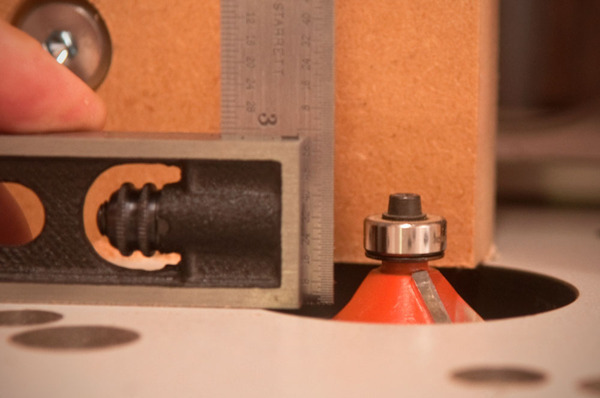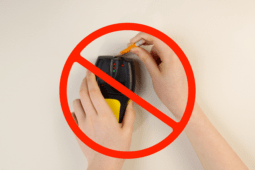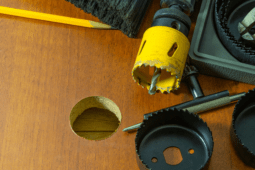ManMade Essential Toolbox: The Best Combination Square for Woodworking… and Why You Definitely Need One
The best combination square will quickly become essential in your shop. ManMade is sharing our picks for the essential tools we think every creative guy and DIYer needs. We’ve selected useful, long-lasting tools to help you accomplish a variety of projects, solve problems, and live a hands-on lifestyle that allows you to interact with and make the things you use every day.

The saying goes, “Measure twice, cut once.” So does that mean that the layout and setup process is twice as important as the sizing and milling? Absolutely. In fact, it may be more like three or four more times. Any person who’s completed a full-on woodworking project can attest: you spend much, much more time getting your parts and tools ready then you do actually using them. And if you use power tools, the cutting time is trimmed down even more. Tape measures are great for rough work, and calipers for small parts and thickness measuring, but for most tasks like laying out joinery, setting up machinery, or checking for square, you need: a great adjustable combination square for woodworking.
Which, as it turns out, isn’t a woodworking tool at all; it’s for machinists. But in the modern era of hand tools and power tools, there’s no better way to measure, well, almost everything.

What to Look For in the Best Combination Square?
There are a variety of types of squares, but the most commonly used is the 12″ combination square, so that’s where to start. You want a tool with 4R graduations (meaning 1/8, 1/16, 1/32, and 1/64″) with etched markings that are easy to read (as opposed to stamped).
The best combination square is more than just a ruler with a sliding thingie on it. It becomes a reliable way to check for 90° and 45° on any stock or tool, as a reference surface for determining flatness, a depth gauge, a way to transfer dimensions, a center finder, and the like.
Which Types and Sizes of Combination Squares Should I Get?
More complex combination square kits include protracting and center-finding heads, but, while occasionally useful, they just drive up the price for woodworking.
While some prefer a 6″ square as their go-to (it fits easily in an apron pocket), I suggest investing your bucks in a high-quality 12″ combination square. It will last you the rest of your life, and there are so many times in a project when I need an adjustable stop longer than 6″.

Then, for smaller tasks and setups, look for a 4″ (or 6″) double square for precise work on small parts, and to use as a square-reference for tool setup in tight corners without having to remove the head from the ruler. The double square here is nice because you can use either side. With such a small head, the 45° wouldn’t help much at this scale.
Lastly, for basic tasks and nice-to-have convenience, pick up a less expensive 6″ combination square that you can keep in a pocket, throw in your toolbox, etc, or use in tandem with your 12″ when you want to lay out two dimensions on multiple parts.
So, again, the plan of attack here is: invest in the best 12″ square you can afford, and take care of it. Supplement that with a nice-quality 4″ double square for try-square tasks and measuring of small parts (just having a fine ruler is amazing, too). Then, add a “good enough” 6″ square with the standard head for general work. Cool? Cool.

Oh, and you know that little knurled knob on your square? It’s not an adjuster – it’s a scribe point, that allows you to mark lines or points on your work. Keep that in mind next time your pencil is on the other side of the room, and you’ve laid everything out and both hands are holding things in place 😉
Which Combination Square Should I Buy?

You might never suspect it – but if any item in your toolbox exemplifies the “you get what you pay for” adage, it’s a good square. This is finely machined piece of equipment, which takes great care and quality materials to keep things adjustable and easy to use. If you’ve ever touched a Starrett (the cream of the crop for measuring tools) after you’ve become used to you $7.99 hardware store model, it’s like they’re two different tools . A simple pleasure to work, and the accuracy will make your projects that much better.
So, spread your bucks appropriately. Again, that means investing in a nice (but not insane) 12″ square, a reasonable 4″ double square, and a good enough 6″. Cared for, they’ll last for generations to come.

The best combination square you should buy
12″ Combination Square:
- PEC Satin Chrome 12″ Combination Square Set
- Johnson 440 12-Inch Cast Iron Combination Square (check the reviews & details so you know what you’re getting; a good square, just not perfect)
- General Tools & Instruments 812 Carpenters Combination Square
- Starrett 11H-12-4R Combination Square with Cast Iron Head and Black Wrinkle Finish
4″ Double Square
- iGaging 6″ Double Square (note this has a 6″ ruler, but is less expensive than the 4″ and has free Prime shipping)
- Starrett 13A Double Square with hardened blade
6″ Combination Square










